Hassani S. Mathematical Methods: For Students of Physics and Related Fields
Подождите немного. Документ загружается.

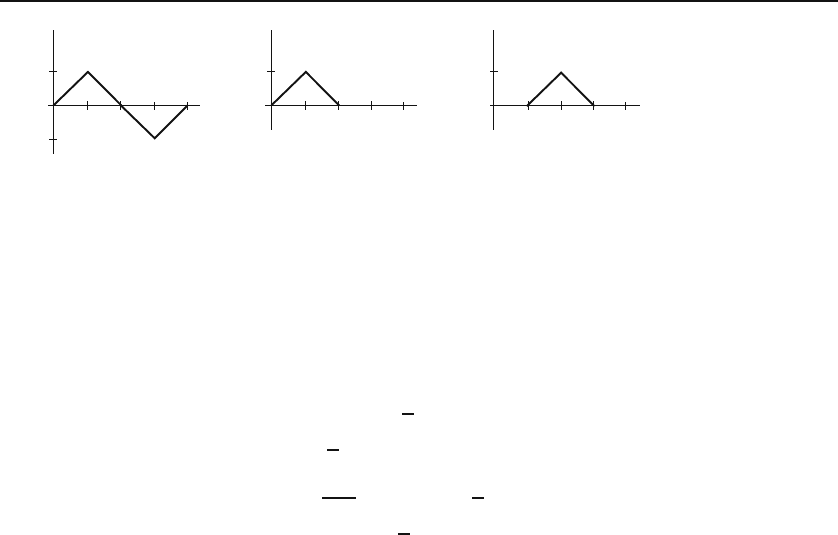
28.4 Problems 689
(c)
a/2 a
a/4
x
ψ (x, 0)
(b)
a/2 a
a/4
x
ψ (x, 0)
(a)
a/2 a
a/4
x
ψ (x, 0)
− a/4
Figure 28.1: The initial shape of the waves.
28.13. Repeat Problem 28.12 assuming that the initial displacement is zero
and the initial velocity distribution is given by each figure.
28.14. Repeat Problem 28.13 assuming that the initial velocity distribution
is given by:
(a) g(x)=
⎧
⎨
⎩
v
0
if 0 ≤ x ≤
a
2
,
0if
a
2
<x≤ a.
(b) g(x)=
⎧
⎨
⎩
v
0
sin
2πx
a
if 0 ≤ x ≤
a
2
,
0if
a
2
<x≤ a.
28.15. A wave guide consists of two coaxial cylinders of radii a and b (b>a).
Find the electric field for a TM mode propagating along the two cylinders in
the region between them. Hint: Both linearly independent solutions of the
Bessel DE are needed for the radial function.
Part VII
Special Topics
Chapter 29
Integral Transforms
Chapters 26 and 27 illustrated the Frobenius method of solving differential
equations using power series, which gives a solution that converges within an
interval of the real line. This chapter introduces another method of solving
DEs, which uses integral transforms. The integral transform of a function
v is another function u given by
u(x)=
#
b
a
K(x, t)v(t) dt, (29.1)
where (a, b) is a convenient interval, and K(x, t), called the kernel of the
kernel of integral
transforms
integral transform, is an appropriate function of two variables.
The idea behind using integral transform is to write the solution u(x)
of a DE in x in terms of an integral such as Equation (29.1) and choose v,
the kernel, and the interval (a, b) in such a way as to render the DE more
Strategy for
solving DEs using
integral transforms
manageable. There are many kernels appropriate for specific DEs. However,
two kernels are most widely used in physics, which lead to two important
integral transforms, the Fourier transform and the Laplace transform.
29.1 The Fourier Transform
Fourier transform has a kernel of the form K(x, t)=e
itx
andaninterval
(−∞, +∞). Let us see how this comes about.
The Fourier series representation of a function F(x) is valid for the entire
real line as long as F (x) is periodic. However, most functions encountered
in physical applications are defined in some interval (a, b) without repetition
beyond that interval. It would be useful if we could also expand such functions
in some form of Fourier “series.”
One way to do this is to start with the periodic series and then let the
period go to infinity while extending the domain of the definition of the func-
tion. As a specific case, suppose we are interested in representing a function
f(x) that is defined only for the interval (a, b) and is assigned the value zero
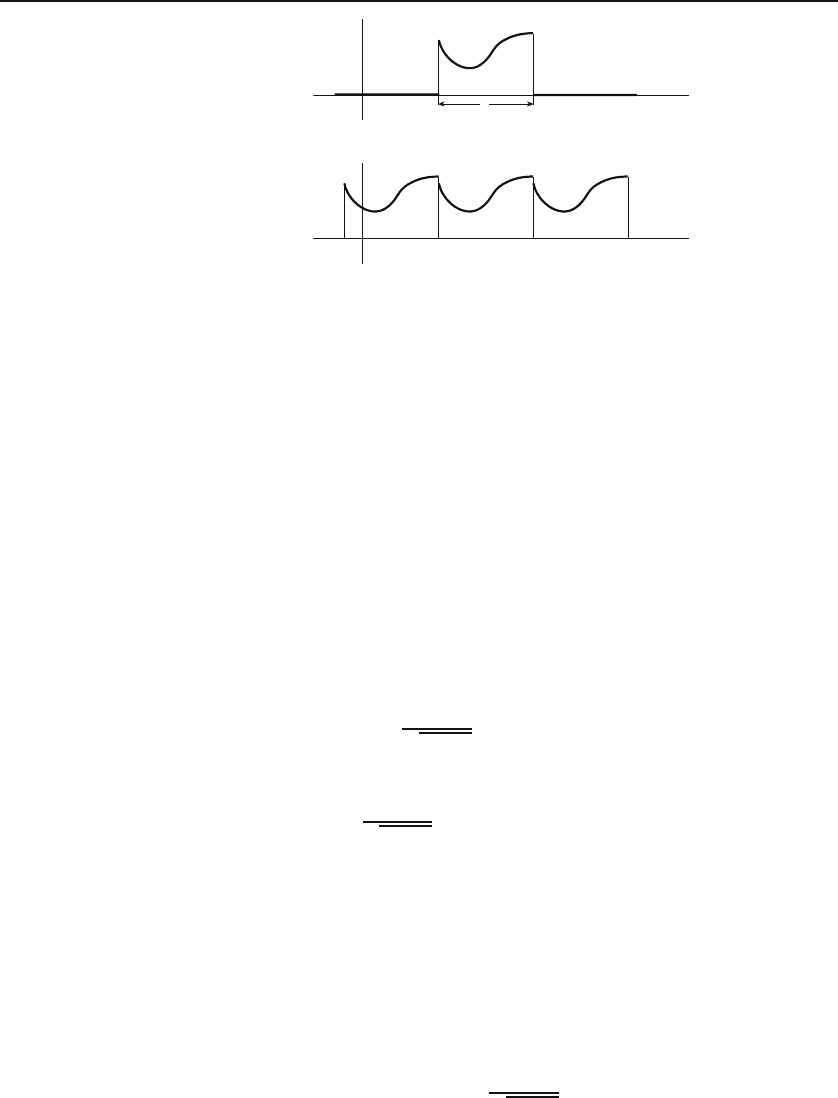
694 Integral Transforms
f (x)
x
L
a
b = a+L
x
a
a+L
+aa–L 2L
(a)
(b)
Figure 29.1: (a) The function we want to represent. (b) The Fourier series represen-
tation of the function.
everywhere else [see Figure 29.1(a)]. To begin with, we might try the Fourier
series representation, but this will produce a repetition of our function. This
situation is depicted in Figure 29.1(b).
Next we may try a function f
Λ
(x) defined in the interval (a−Λ/2,b+Λ/2),
where Λ is an arbitrary positive number:
f
Λ
(x)=
⎧
⎪
⎨
⎪
⎩
0ifa − Λ/2 <x<a,
f(x)ifa<x<b,
0ifb<x<b+Λ/2.
This function, which is depicted in Figure 29.2, has the Fourier series repre-
sentation [see Equation (18.23)]
f
Λ
(x)=
1
√
L +Λ
∞
n=−∞
f
Λ,n
e
2iπnx/(L+Λ)
, (29.2)
where
f
Λ,n
=
1
√
L +Λ
#
b+Λ/2
a−Λ/2
e
−2iπnx/(L+Λ)
f
Λ
(x) dx. (29.3)
We have managed to separate various copies of the original periodic func-
tion by Λ. It should be clear that if Λ →∞, we can completely isolate the
function and stop the repetition. Let us investigate the behavior of Equations
(29.2) and (29.3) as Λ grows without bound. First, we notice that the quan-
tity k
n
defined by k
n
≡ 2nπ/(L + Λ) and appearing in the exponent becomes
almost continuous. In other words, as n changes by one unit, k
n
changes only
slightly. This suggests that the terms in the sum in Equation (29.2) can be
lumped together in j intervals of width Δn
j
, giving
f
Λ
(x) ≈
∞
j=−∞
f
Λ
(k
j
)
√
L +Λ
e
ik
j
x
Δn
j
,
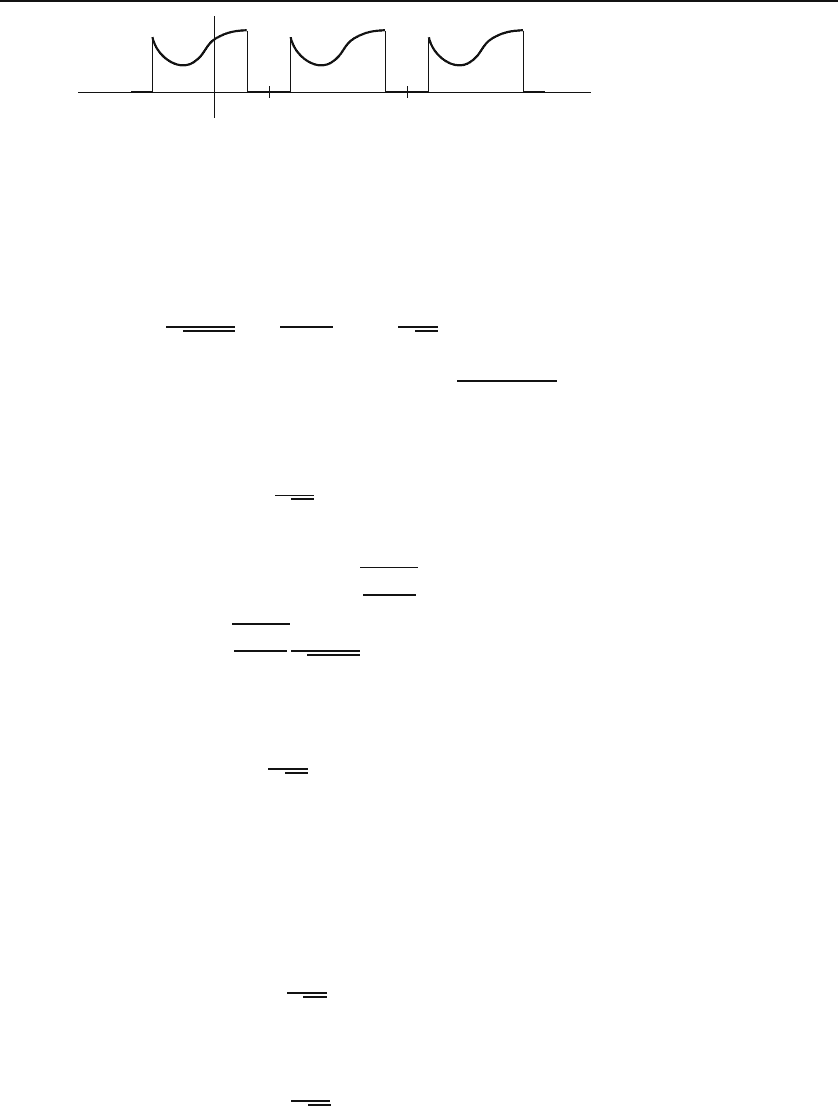
29.1 The Fourier Transform 695
x
a–Λ/2
b+Λ/2
Figure 29.2: By introducing the parameter Λ, we have managed to separate the copies
of the function.
where k
j
≡ 2n
j
π/(L +Λ), and f
Λ
(k
j
) ≡ f
Λ,n
j
. Substituting Δn
j
=[(L +
Λ)/2π]Δk
j
in the above sum, we obtain
f
Λ
(x) ≈
∞
j=−∞
f
Λ
(k
j
)
√
L +Λ
e
ik
j
x
L +Λ
2π
Δk
j
=
1
√
2π
∞
j=−∞
˜
f
Λ
(k
j
)e
ik
j
x
Δk
j
,
where we introduced
˜
f
Λ
(k
j
) defined by
˜
f
Λ
(k
j
) ≡
(L +Λ)/2πf
Λ
(k
j
). It is
now clear that the preceding sum approaches an integral in the limit that
Λ →∞. In the same limit, f
Λ
(x) → f (x), and we have
f(x)=
1
√
2π
#
∞
−∞
˜
f(k)e
ikx
dk, (29.4)
where
Fourier and
inverse Fourier
transforms
˜
f(k) ≡ lim
Λ→∞
˜
f
Λ
(k
j
) = lim
Λ→∞
L +Λ
2π
f
Λ
(k
j
)
= lim
Λ→∞
L +Λ
2π
1
√
L +Λ
#
b+Λ/2
a−Λ/2
e
−ik
j
x
f
Λ
(x) dx,
or
˜
f(k)=
1
√
2π
#
∞
−∞
f(x)e
−ikx
dx. (29.5)
The function f in (29.4) is called the Fourier transform of
˜
f and
˜
f in (29.5)
is called the inverse Fourier transform of f . Note that the difference
between the two transforms is the sign of the exponential in the integrand.
Another notation that is commonly used for Fourier transform of a func-
tion f is F[f]. The inverse Fourier transform of a function g is then denoted
by F
−1
[g]. This means that F[f]isafunction whose value at x is given by
F[f](x)=
1
√
2π
#
∞
−∞
f(k)e
ikx
dk, (29.6)
Similarly, F
−1
[g] is a function whose value at k is given by
F
−1
[g](k)=
1
√
2π
#
∞
−∞
g(x)e
−ikx
dx, (29.7)

696 Integral Transforms
Note that the use of k and x in these two equations is completely arbitrary.
The only requirement is that the function and the variable in its argument
on the left appear, respectively, in the integrand and in the exponent on the
right. For example, (29.6) could be written as
F[f](k)=
1
√
2π
#
∞
−∞
f(x)e
ikx
dx, or F[h](t)=
1
√
2π
#
∞
−∞
h(ω)e
iωt
dω,
and (29.7) as
F
−1
[g](x)=
1
√
2π
#
∞
−∞
g(k)e
−ikx
dk or F
−1
[f](y)=
1
√
2π
#
∞
−∞
f(x)e
−ixy
dx.
29.1.1 Properties of Fourier Transform
Equations (29.4) and (29.5) are reciprocals of one another. However, it is not
obvious that they are consistent. In other words, if we substitute (29.4) in
the RHS of (29.5), do we get an identity? Let’s try this:
˜
f(k)=
1
√
2π
#
∞
−∞
dx e
−ikx
1
√
2π
#
∞
−∞
˜
f(k
)e
ik
x
dk
=
1
2π
#
∞
−∞
dx
#
∞
−∞
˜
f(k
)e
i(k
−k)x
dk
.
We now change the order of the two integrations:
˜
f(k)=
#
∞
−∞
dk
˜
f(k
)
1
2π
#
∞
−∞
dx e
i(k
−k)x
.
But the expression in the square brackets is the Dirac delta function given by
Equation (18.28). Thus, we have
˜
f(k)=
∞
−∞
dk
˜
f(k
)δ(k
− k), which is an
identity. In the F notation, this result can be written as
F
−1
F[f]=FF
−1
[f]=f, (29.8)
for any function f . The second identity can be shown similarly. Another
property enjoyed by the Fourier transform and its inverse in linearity.Ifa
and b are constants and f and g functions, then
F[af + bg]=aF[f]+bF[g], and F
−1
[af + bg]=aF
−1
[f]+bF
−1
[g].
(29.9)
It is useful to generalize Fourier transform equations to more than one
dimension. The generalization is straightforward:
F[
˜
f](r) ≡ f(r)=
1
(2π)
n/2
##
Ω
k
∞
d
n
ke
ik·r
˜
f(k),
F
−1
[f](k) ≡
˜
f(k)=
1
(2π)
n/2
##
Ω
x
∞
d
n
xf(r)e
−ik·r
. (29.10)
where n is usually 2 or 3, Ω
k
∞
is the entire k-space, and Ω
x
∞
is the entire
x-space.

29.1 The Fourier Transform 697
29.1.2 Sine and Cosine Transforms
The complex exponential in the definition of Fourier transform or its inverse
can be broken down into its trigonometric parts. Then for an even function,
the cosine part contributes and for an odd function, the sine part contributes.
In either case, the integration
∞
−∞
can be equated to 2
∞
0
. This leads to
the sine transform and cosine transform denoted by F
s
[f]andF
c
[f],
respectively, for any function:
Sine and cosine
transforms
F
s
[f](x)=
2
π
#
∞
0
f(k)sinkxdk,
F
c
[f](x)=
2
π
#
∞
0
f(k)coskxdk. (29.11)
What is the inverse of a cosine transform? To find out, let F (x)denote
the left-hand side of the second equation in (29.11). Multiply both sides of
the equation by cos k
x—with k
> 0—and integrate over all positive values
of x to get
#
∞
0
F (x)cosk
xdx =
2
π
#
∞
0
f(k)dk
#
∞
0
cos kx cos k
xdx. (29.12)
Writing the cosines in terms of exponential, the x integration on the right
gives
#
∞
0
cos kx cos k
xdx =
1
4
#
∞
0
e
ikx
+ e
−ikx
!
e
ik
x
+ e
−ik
x
dx
=
1
4
#
∞
0
*
e
ix(k+k
)
+ e
−ix(k+k
)
+ e
ix(k−k
)
+ e
−ix(k−k
)
+
dx
=
1
4
#
∞
−∞
e
ix(k+k
)
dx +
1
4
#
∞
−∞
e
ix(k−k
)
dx
=
π
2
[δ(k + k
)+δ(k − k
)] .
To go from the second to third line, we used
∞
0
e
−iax
dx =
0
−∞
e
iax
dx,which Inverses of sine
and cosine
transforms
the reader can easily verify; and to go from the third to the last line, we used
Equation (18.28). Substituting the last result in (29.12), we obtain
#
∞
0
F (x)cosk
xdx =
π
2
#
∞
0
f(k)δ(k + k
)dk
=0 (Reader, why?)
+
π
2
#
∞
0
f(k)δ(k − k
)dk
=
π
2
f(k
),
or
f(k
)=
2
π
#
∞
0
F (x)cosk
xdx.
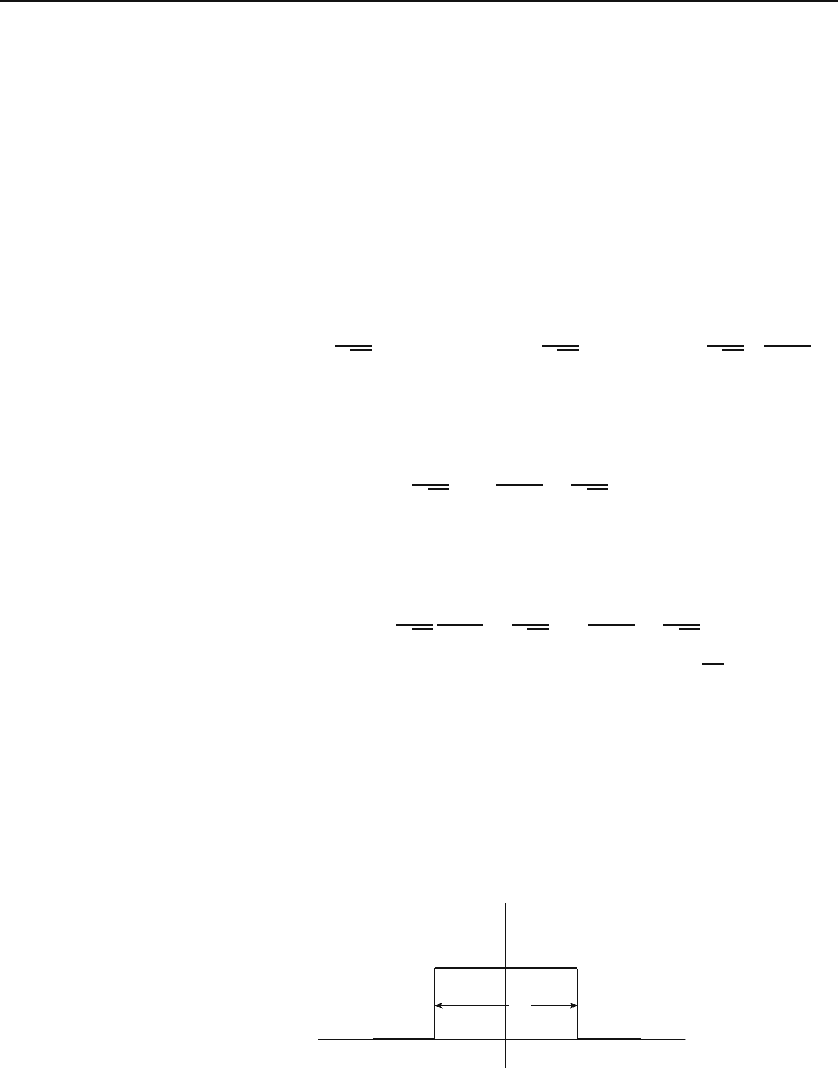
698 Integral Transforms
This shows that the inverse of a cosine transform is another cosine trans-
form. Similarly, one can show that the inverse of a sine transform is another
sine transform. We shall not use sine or cosine transforms, as the Fourier
transform, with the exponential in the integrand, is much more convenient.
29.1.3 Examples of Fourier Transform
Example 29.1.1. Let us evaluate the inverse Fourier transform of the function
defined by
f(x)=
0
b if |x| <a,
0if|x| >a
(see Figure 29.3). From (29.5) and (29.7) we have
F
−1
[f](k) ≡
˜
f(k)=
1
√
2π
#
∞
−∞
f(x)e
−ikx
dx =
b
√
2π
#
a
−a
e
−ikx
dx =
2ab
√
2π
sin ka
ka
,
which is the function encountered on page 491 and depicted in Figure 18.7.
This result deserves some detailed discussion. First, note that if a →∞,the
function f(x) becomes a constant function over the entire real line, and we get
˜
f(k)=
2b
√
2π
lim
a→∞
sin ka
k
=
2b
√
2π
πδ(k)
by Equation (18.27). This is the Fourier transform of an everywhere-constant func-
tion (see Problem 29.1). Next, let b →∞and a → 0 in such a way that 2ab,which
is the area under f(x), is 1. Then f(x) will approach the delta function, and
˜
f(k)
becomes
˜
f(k) = lim
b→∞
a→0
2ab
√
2π
sin ka
ka
=
1
√
2π
lim
a→0
sin ka
ka
=
1
√
2π
.
So the Fourier transform of the delta function is the constant 1/
√
2π as implied by
(29.5).
Finally, we note that the width of f(x)isΔx =2a, and the width of
˜
f(k)is
roughly the distance, on the k-axis, between its first two roots, k
+
and k
−
,oneither
side of k =0: Δk = k
+
− k
−
=2π/a. Thus increasing the width of f(x)results
in a decrease in the width of
˜
f(k). In other words, when the function is wide, its
Fourier transform is narrow. In the limit of infinite width (a constant function), we
get infinite sharpness (the delta function). The last two statements are very general.
In fact, it can be shown that ΔxΔk ≥ 1 for any function f(x). When both sides
x
a
b
–a
f
(x)
Δ
x
Figure 29.3: The square “bump” function.
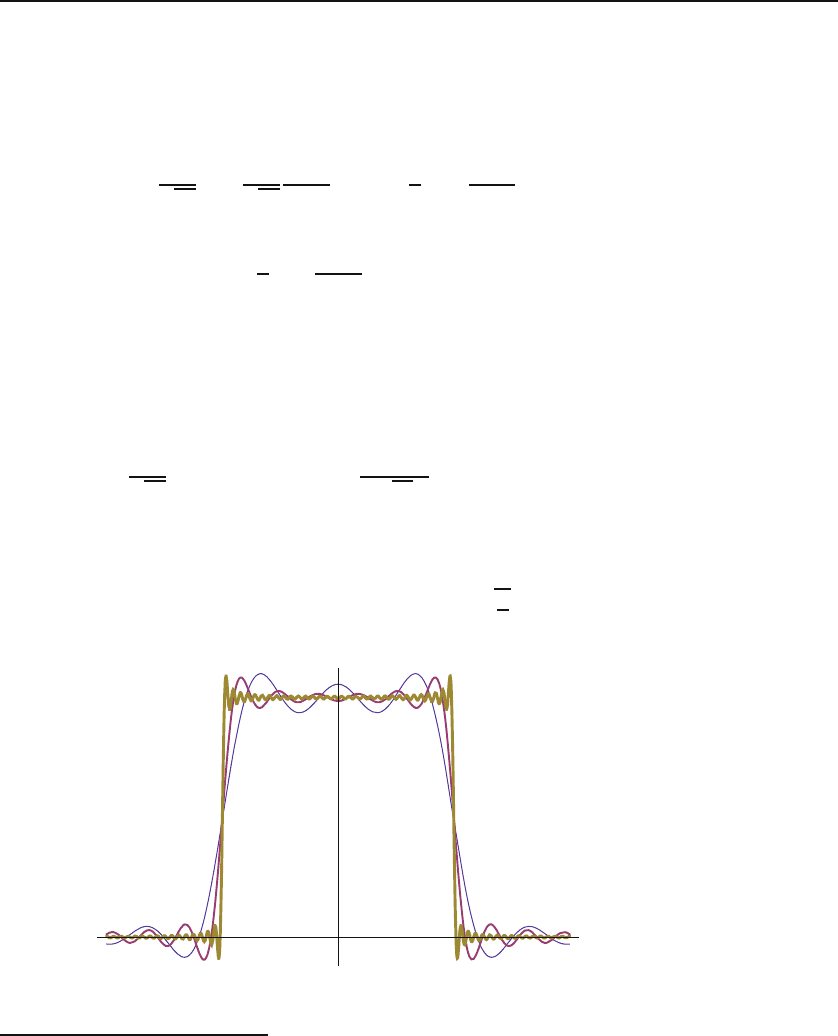
29.1 The Fourier Transform 699
of this inequality are multiplied by the (reduced) Planck constant ≡ h/(2π), the
result is the celebrated Heisenberg uncertainty relation:
1
Heisenberg
uncertainty
relation
ΔxΔp ≥ ,
where p = k is the momentum of the particle.
Having obtained the transform of f(x), we can write
f(x)=
1
√
2π
#
∞
−∞
2b
√
2π
sin ka
k
e
ikx
dk =
b
π
#
∞
−∞
sin ka
k
e
ikx
dk.
Figure 29.4 shows the integral
b
π
#
K
−K
sin ka
k
e
ikx
dk
when K = 10, K = 20, and K = 100. It is seen that by making the limits
of integration larger and larger, the graph approximates Figure 29.3 better and
better.
Example 29.1.2. Let us evaluate the Fourier transform of a Gaussian g(x)=
ae
−bx
2
with a, b > 0:
˜g(k)=
a
√
2π
#
∞
−∞
e
−b(x
2
+ikx/b)
dx =
ae
−k
2
/4b
√
2π
#
∞
−∞
e
−b(x+ik/2b)
2
dx.
To evaluate this integral rigorously, we would have to use the calculus of residues
developed in Chapter 21. However, we can ignore the fact that the exponent is
complex, substitute y = x + ik/(2b), and write
#
∞
−∞
e
−b[x+ik/(2b)]
2
dx =
#
∞
−∞
e
−by
2
dy =
π
b
.
Figure 29.4: The thinnest plot represents K =10; the next thinnest plot represents
K =20; and the thickest plot represents K = 100.
1
In the context of the uncertainty relation, the width of the function—the so-called
wave packet—measures the uncertainty in the position x of a quantum mechanical particle.
Similarly, the width of the Fourier transform measures the uncertainty in k, which is related
to momentum p via p = k.

700 Integral Transforms
Thus,wehave˜g(k)=
a
√
2b
e
−k
2
/(4b)
, which is also a Gaussian.
We note again that the width of g(x), which is proportional to 1/
√
b,isininverse
relation to the width of ˜g(k), which is proportional to
√
b. WethushaveΔxΔ
k ∼ 1.
Example 29.1.3. In this example we evaluate the inverse Fourier transform of the
Coulomb potential V (r)ofapointchargeq at the origin: V (r)=k
e
q/r.Theinverse
Fourier transform is important in scattering experiments with atoms, molecules, and
solids. As we shall see in the following, the inverse Fourier transform of V (r)isnot
defined. However, if we work with the Yukawa p otential,Yukawa potential
V
α
(r)=
k
e
qe
−αr
r
,α>0,
the inverse Fourier transform will be well-defined, and we can take the limit α → 0
to recover the Coulomb potential. Thus, we seek the inverse Fourier transform of
V
α
(r).
We are working in three dimensions and therefore may write
F
−1
[V
α
](k) ≡
˜
V
α
(k)=
1
(2π)
3/2
##
Ω
x
∞
d
3
xe
−ik·r
k
e
qe
−αr
r
.
It is clear from the presence of r that spherical coordinates are appropriate. We
are free to pick any direction as the z-axis. A simplifying choice in this case is the
direction of k.So,weletk = |k|
ˆ
e
z
= k
ˆ
e
z
,ork · r = kr cos θ,whereθ is the polar
angle in spherical coordinates. Now we have
˜
V
α
(k)=
k
e
q
(2π)
3/2
#
∞
0
r
2
dr
#
π
0
sin θdθ
#
2π
0
dϕe
−ikr cos θ
e
−αr
r
.
The ϕ integration is trivial and gives 2π.Theθ integration simplifies if we make
the substitution u =cosθ:
#
π
0
sin θe
−ikr cos θ
dθ =
#
1
−1
e
−ikru
du =
1
ikr
(e
ikr
− e
−ikr
).
We thus have
˜
V
α
(k)=
k
e
q(2π)
(2π)
3/2
#
∞
0
dr r
2
e
−αr
r
1
ikr
(e
ikr
− e
−ikr
)
=
k
e
q
(2π)
1/2
1
ik
#
∞
0
dr
*
e
(−α+ik)r
− e
−(α+ik)r
+
=
k
e
q
(2π)
1/2
1
ik
e
(−α+ik)r
−α + ik
∞
0
+
e
−(α+ik)r
α + ik
∞
0
.
Note how the factor e
−αr
has tamed the divergent behavior of the exponential at
r →∞. This was the reason for introducing it in the first place. Simplifying the last
expression yields
˜
V
α
(k)=(2k
e
q/
√
2π)(k
2
+ α
2
)
−1
. The parameter α is a measure of
the range of the potential. It is clear that the larger α is, the smaller the range. In
fact, it was in response to the short range of nuclear forces that Yukawa introduced
α. For electromagnetism, where the range is infinite, α becomes zero and V
α
(r)
reduces to V (r). Thus, the inverse Fourier transform of the Coulomb potential is
˜
V
Coul
(k)=
2k
e
q
√
2π
1
k
2
.
